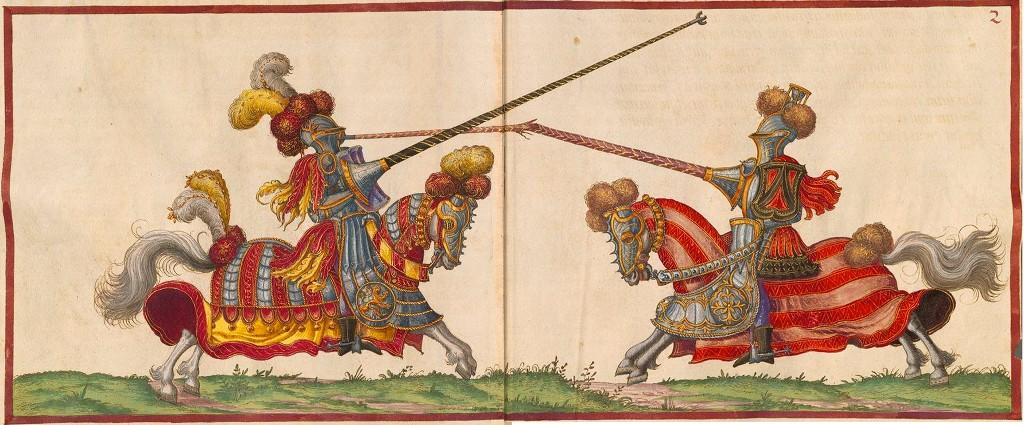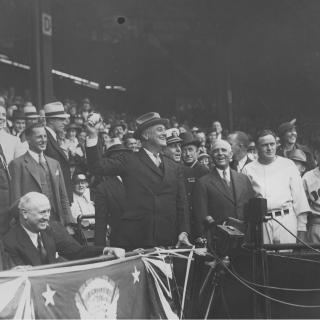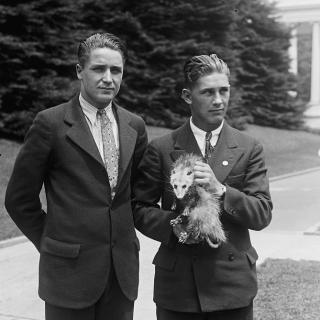Jousting Over Maryland's State Sport
The battle lines were drawn anew early in February 1988. The knights stood together, clad in mail and livery, and braced their lances in readiness. For more than twenty-five years, they had desperately defended their title against the onslaughts of the enemy. Once more, the enemy was in the capitol, and once more the knights of the Maryland Jousting Tournament Association would resist the dishonor of lacrosse becoming the official state sport.
When a state legislature selects an official sport, the chosen activity usually represents a tradition or some essential quality of the state identity. Alaska, home of the Iditarod, selected dog mushing.[1] Likewise, Texas and California picked sports iconic to their histories and cultural images: rodeo and surfing, respectively.[2] In 1962, the Maryland General Assembly faced the question of what sport best represented the unique history and character of the state and its people. In what might be a surprise to many readers today, the lawmakers in Annapolis picked a centuries-old tourney competition derived from medieval combat techniques.
Jousting first emerged in the eleventh century as a form of staged combat, in which mounted warriors entertained crowds of spectators by charging at one another in thunderous crashes of lance and shield.[3] The modern version of jousting recognized by the laws of Maryland is somewhat more subdued; contestants try to spear rows of rings rather than blast their opponents from their saddles.[4] However, the modern sport maintains some of the pomp and pageantry of the knightly competitions. Competitors are required to choose a fanciful title to compete under (e.g. Knight of Cedar Lane or Maid of Bartram Manor), with the winner crowning a “Queen of Love and Beauty” at the conclusion of the events.[5]
The sport version of jousting has been practiced in Maryland since the early days of the colony but truly gained popularity in the years following the Civil War.[6] In 1866, the St. Mary’s Gazette printed an article celebrating a jousting tournament in Prince George’s County meant to raise money for Southerners after the war; one of the participants rode under the rather unsubtle nom de guerre of “Knight of the Lost Cause.”[7]
Over the following decades, jousting remained a popular, if niche, sport in Southern Maryland. Its ongoing draw is attested by semi-regular feature pieces in local newspapers. The journalistic accounts brought a number of contestants into the spotlight, such as Jacob Burtner (Knight of Elm Hill), the seventy-year-old Knight of Elm Hill who had jousted since 1903, and Mary Lou (Maid of Bartram Manor) and George Bartram (Knight of Cedar Lane), the brother and sister pair that started the Maryland Jousting Tournament Association in 1950.[8] However, perhaps the most impactful jouster in the public eye was Henry J. Fowler (Knight of Mechanicsville), who was both president of the Maryland Jousting Tournament Association and a state delegate in 1962. In February, Fowler introduced a bill to make jousting the official sport of Maryland and the first state sport in the nation.[9] At the time of the bill’s introductions, jousters claimed that it was it was “the only true Maryland sport” and that the rear of the state seal had a portrait of an armored Lord Baltimore astride a warhorse.[10] On March 6, 1962, H.B.-80 passed the State Senate and jousting was enshrined in Maryland law.[11]
Although fans of jousting were successful in securing the official recognition of their sport, the legislature’s decision sparked almost immediate backlash from lacrosse enthusiasts. Like jousting, lacrosse has had a long and storied history in the state of Maryland. Lacrosse was created by the people of the Six Nations of the Iroquois in what would become New York and Canada.[12]
In 1878, the sport made its way to Maryland after it was picked up by members of the Baltimore Athletic Club and it was rapidly adopted by local universities like Johns Hopkins and the University of Maryland. By the time that jousting was selected as the official state sport, Maryland’s lacrosse teams were among the best in the nation. To this day, UMD’s men’s lacrosse team has never had a losing season and its rivalry with Johns Hopkins is one of the most significant in the sport.[13] The popularity of lacrosse in Maryland was a major point of contention, with one Baltimore Sun commentator stating that instead of jousting, “our great state should be represented by a sport at which we are truly great.”[14]
For the next forty years, jousters and lacrosse players engaged in a West Side Story-esque rivalry over which sport was most deserving of the official state designation. In 1967 and 1968, Delegate Harry W. Nice III introduced two bills into the state legislature to replace jousting with lacrosse.[15] On March 12, 1967 Henry Fowler announced to the House that Governor Spiro Agnew would be escorted to the General Assembly Ball by a squadron of costumed knights, at which point Nice “jumped to his feet” and declared “We will equip 12 lacrosse players… with sticks and cleats on their feet, and either escort the Governor in or the jousters out.”[16]Although neither bill was successful, the lacrosse contingent tried and failed again in 1974 and 1988 to secure their sport’s recognition and introduced a new gambit of calling for lacrosse to be mutually recognized alongside jousting as Maryland’s official “team sport.”[17]
During the 1988 campaign, factional battlelines emerged outside the state house, as “lacrosse men appeared in coat and tie, lugging their sticks and the jousters came dressed in medieval costumes wielding lances.”[18] For some, the conflict had entered a new stage of fatigue and mockery. Baltimore Sun sports columnist Pat O’Malley openly criticized the focus on the state sport over other pressing issues like the AIDS crisis and the decline of the Chesapeake Bay, stating that “at least now, if anyone inquires about the state sport, they will view jousting as just a good natured joke. Proposing lacrosse as state sport is even more of a joke.”[19] Others turned to a new third faction, duckpin bowling, which was actually invented in Maryland.[20]
By 2004, the jousters had reached the end of their reserves. When a new bill supporting lacrosse as the state team sport was introduced that year, the lacrosse faction sent hundreds of letters and emails to the bill’s creator while their knightly opponents could only muster “three or four letters and a handful of emails.”[21] Lacrosse was officially recognized as the state team sport that year.[22] Mercifully, the war was over.
Footnotes
- ^ “Alaska Statutes 2020.” http://www.akleg.gov/basis/statutes.asp#44.09.078.
- ^ “Texas State Symbols - Texas State Library and Archives Commission | TSLAC.” https://www.tsl.texas.gov/ref/abouttx/symbols.html.; “Bill Text - AB-1782 Surfing.” https://leginfo.legislature.ca.gov/face/billTextClient.xhtml?bill_id=20….
- ^ Richard W. Barber & Juliet R.V. Barker, Tournaments: jousts, chivalry and pageants in theMiddle Ages (Woodbridge, 1989), p. 2
- ^ Maryland Jousting Tournament Association. “Handbook.” http://www.marylandjousting.com/handbook.html.
- ^ Ibid.
- ^ Maryland Manual On-Line: A Guide to Maryland & Its Government. “Jousting & Lacrosse, Maryland State Sports.” Accessed May 20, 2022. https://msa.maryland.gov/msa/mdmanual/01glance/html/symbols/sport.html#….
- ^ St. Mary’s Gazette. “Tournament and Fair,” June 7, 1866. https://chroniclingamerica.loc.gov/lccn/sn89060120/1866-06-07/ed-1/seq-….
- ^ Henry, Frank. “Knight Without Armor: Jousting Is the World’s Greatest Sport to Jacob Burtner, and at 70 He Still Wins.” The Sun. October 3, 1948.
- ^ “5 House Votes Give Tax Help.” The Sun. February 28, 1962.
- ^ “State Sport?” The Sun. February 18, 1962.
- ^ “Maryland Legislative Routine.” The Sun. March 7, 1962.
- ^ Flynn, Tom. Men’s Lacrosse in Maryland: The Pride of the Old Line State. History Press Library Editions, 2016, p 19.
- ^ Stubbs, Roman. “40 Years after Its Last NCAA Lacrosse Title, Maryland Asks, Why Not Us?” The Washington Post, May 22, 2015. https://www.washingtonpost.com/sports/colleges/40-years-after-its-last-ncaa-lacrosse-title-maryland-asks-why-not-us/2015/05/22/0f87242a-0084-11e5-805c-c3f407e5a9e9_story.html; Flynn, 276.
- ^ Welsh, Chris. “Lacrosse, Not Jousting, Should Be the State Sport.” The Sun. November 18, 1979.
- ^ “Jousting Faces New Challenge.” The Sun. February 8, 1968.
- ^ Homan, Richard. “Jousting’s No Jest In Md. Legislature: Jousting and Lacrosse Are No Jest If Md. Legislators Are Concerned.” The Washington Post. March 13, 1967.
- ^ Cramer, Richard Ben. “Lady Jouster Unseats Lacrosse Fan.” The Sun. March 1, 1974; See also Guidera, Mark. “State Legislators Expected to Joust over State Sport.” The Sun. December 6, 1987.
- ^ Zorzi, Jr., William F. “State’s Official Jousters Insist Lances, Sticks Don’t Mix.” The Sun. February 10, 1988.
- ^ Malley, Pat O. “SIDELINES: Lacrosse for State Sport! Is This a Legislative Joke?” The Sun. January 25, 1988.
- ^ McCord, Joel. “Duckpins a State Sport? Surely You Joust.” The Sun. October 28, 1991.
- ^ Phillips, Angus. “Maryland Might No Longer Be Stuck on Jousting.” The Washington Post (1974-). February 4, 2004, sec. Sports.
- ^ Maryland Manual On-Line: A Guide to Maryland & Its Government. “Jousting & Lacrosse, Maryland State Sports.” Accessed May 20, 2022. https://msa.maryland.gov/msa/mdmanual/01glance/html/symbols/sport.html#…






![Sketch of the mythical fuan by Pearson Scott Foresman. [Source: Wikipedia]](/sites/default/files/styles/crop_320x320/public/2023-10/Goatman_Wikipedia_Faun_2_%28PSF%29.png?h=64a074ff&itok=C9Qh-PE1)












